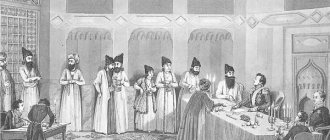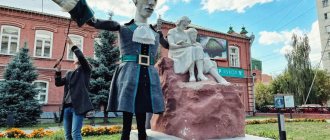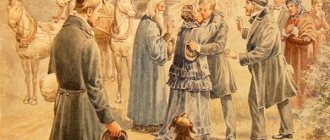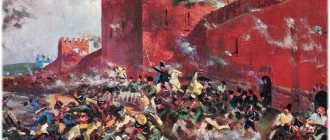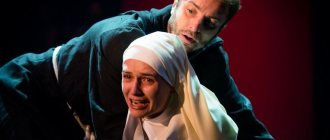Chapaev and Emptiness, plot, critics' opinions, publications, film adaptations, additional facts
| Name | Chapaev and Emptiness |
| Genre | novel |
| Author | Victor Pelevin |
| Original language | Russian |
| Separate edition | 1996 |
| Publishing house | Vagrius |
“Chapaev and Emptiness” is a novel by Victor Pelevin, written in 1996. The author himself characterizes his work as “The first work in world literature, the action of which takes place in absolute emptiness.” In 1997, the novel was included in the list of candidates for the Small Booker Prize.
Plot
The novel covers two periods - Russia 1918-1919 and the mid-1990s. The central plan of the story is the relationship between Vasily Chapaev and the decadent poet Pyotr Pustota (the author himself later admitted that the combination of such “incompatible” personalities became one of the main tasks set for him).
The secondary plans are the story of Serdyuk, who was drawn into the war of the Japanese Taira and Minamoto clans and subsequently attempted suicide; as well as the line of Maria and Arnold Schwarzenegger. In symbolic terms, both lines correspond to the possible future of Russia - the so-called “alchemical marriage” with the East (in Serdyuk’s reality) or with the West (Maria’s reality).
The last, fourth, line symbolizes the logic of a superman in the person of the bandit Volodin. All four - Pyotr Pustota, Serdyuk, Maria and Volodin are in a psychiatric hospital, where they are undergoing a rehabilitation course using the method of Timur Timurovich Kanashnikov.
At the beginning of the story, Timur Timurovich explains to the newly arrived Void that his rehabilitation method consists of a “joint hallucinatory experience” - four patients, being in the same ward, are united by a common goal of recovery.
An important “supra-plot” character is Grigory Kotovsky, who is assigned the role of “demiurge”. According to the mythology of the novel, it is he who is responsible for the fate of modern Russia; towards the end, in a dialogue with the driver, Pyotr Pustota talks about Kotovsky’s “abuse of cocaine” and the obvious consequences of this addiction.
Emptiness himself believed that the world of revolutionary Russia is real, and the mental hospital is just a dream of his imagination, but Chapaev (presented in the novel as a bodhisattva and gradually becoming the Buddhist teacher of Emptiness) tries to convince Peter that both worlds are unreal. The novel is structured as a series of “insert stories” revolving around a central plot: the path of Peter the Void to unexpected enlightenment (satori), which Chapaev helps him achieve.
Critics' opinions
beginning of quote The novel is incomparable, no matter what page you start reading from. Dialogues alone can become the subject of a (re)reader cult.
That is why Pelevin’s prose is intended for regular readers. It contains both poison and antidote. His books are a course of treatment, therapy of consciousness.
These are four elements gathered together, concentrated energy that does not allow you to relax for a moment.
beginning of quotation As a result, the safest media find themselves in the front row of the cultural portrait gallery:
Editions
- Victor Pelevin, Vagrius
- Victor Pelevin, Vagrius
- Victor Pelevin, Vagrius
- 1996 - Victor Pelevin., M., Vagrius, 1996
- 1998 - Victor Pelevin., Vagrius, 1998
- 1999 - Victor Pelevin., Vagrius, 1999
- 1999 - Victor Pelevin., Vagrius, 1999
- 2000 - Victor Pelevin., Vagrius, 2000
- 2001 - Victor Pelevin., Penguin Books, 2001
- 2003 - Victor Pelevin., Vagrius, 2003
- 2003 - Victor Pelevin., Vagrius, 2003
- 2003 - Victor Pelevin., Vagrius, AST, 2003
- 2003 - Victor Pelevin., Vagrius, 2003
- 2003 - Victor Pelevin., Vagrius, 2003
- 2003 — Viktor Pelevin., Cankarjeva založba, 2003, Ljubljana, Slovenia translator: Borut Krashevec
- 2004 - Victor Pelevin., Vagrius, 2004
- 2004 - Victor Pelevin., Vagrius, 2004
- 2004 - Victor Pelevin., Vagrius, 2004
- 2004 - Victor Pelevin., Eksmo, 2004
- 2004 - Victor Pelevin., Vagrius, 2004
- 2006 - Victor Pelevin., Union, 2006
- 2006 - Victor Pelevin., Union, 2006
- 2007 - Victor Pelevin., Eksmo, 2007
- 2009 - Victor Pelevin., Eksmo, 2009
Film adaptations
- "Buddha's Little Finger" (Germany)
Additional facts
- In 2001, Chapaev and the Void (in English translation, under the title The Clay Machine-Gun) was a finalist for the Dublin Literary Prize.
- The book is mentioned in 11th grade literature classes at a Belarusian high school as an example of the “postmodern layer of modern literature” 2012
- For 12 years now there has been a theatrical production of “Chapaev and Emptiness” directed by Pavel Ursul with Mikhail Efremov, Mikhail Politsemako, Mikhail Krylov and Pavel Sborshchikov in the leading roles.
- Alexander Solzhenitsyn and Alexander Sokurov spoke negatively about the novel as part of a conversation about Russian literature in the film “Conversations with Solzhenitsyn.”
- In 2013, an interactive version of the novel was released for iPad, produced by the Internet company Enaza in collaboration with the author.
Source: https://www.cultin.ru/books-chapaev-i-pustota
Pelevin “Chapaev and Emptiness” - summary
Pelevin
- all works
Pelevin
- essays on the work
Page: [ 1 ]
One of Pelevin’s fundamental works is built around one of the most fundamental psychological images, around the archetype of the quadritz. There are four patients in one ward of a psychiatric hospital. Each one in turn tells his story, or, more precisely, not a story, but describes his world. In one of the worlds, the corresponding character enters into an alchemical marriage with the West (mental patient Just Maria - with Schwarzenegger). In another - into an alchemical marriage with the East (Serdyuk - with the Japanese Kavibata). One of the worlds is the world of the main character, Peter the Void, who, together with Vasily Ivanovich Chapaev and Anna, is fighting on the Eastern Front (the central world of the story). The fourth world (the narrator is the crazy bandit Volodin) itself breaks down into four component parts of the narrator’s personality: the internal defendant, the internal prosecutor, the internal lawyer and “the one who enjoys the eternal high.” The repeated quaternity, as it were, strengthens the central symbolism of the work for those readers who did not understand it from the symbolic figure of four patients in one ward.
The archetype of the quaternity, despite the formal simplicity of the plot (a madman is discharged from the hospital because he experiences an epiphany, although not the one the doctor expected, namely: the patient comes to the conclusion that this world is illusory), gives the work depth and versatility.
The text also abundantly presents symbolism, so to speak, of the second row. For example, a fragment: “We found ourselves on a dirt road going uphill. A gentle cliff began at its left edge, and on the right stood a weathered stone wall of an amazingly beautiful pale lilac hue,” represents a chain of symbols that appear in dreams, which are called great dreams. The cliff on the left here means the unconscious of a person, the stone mountain on the right is consciousness. The rise symbolizes the difficulty of plunging into the unconscious (consciousness gets in the way).
Of course, Pelevin himself does not come up with the entire philosophical background of his work. This is a literary text. An obvious borrowing is Baron Yungern’s manipulations with Petka; they surprisingly accurately repeat the rituals of Don Juan, the teacher of Carlos Castaneda.
Pelevin deliberately takes the life and thoughts of Vasily Ivanovich Chapaev as a parallel plot of the story. Here the author combines the simplicity of anecdotal images worn to holes by popular rumor with the philosophical depth and sincerity of the conversations of these same characters in the book. This opposition prepares the reader to perceive the main conflict of the work, the conflict between reality and the idea of it. Does this world really exist? He is no more real than that Vasily Ivanovich who lives in jokes.
If Aivazovsky signs on a piece of a mast dangling among the waves, then in Pelevin we find a unique signature, a description of the style of the writer’s work.
In the scene of Peter the Void meeting his medical record, the author essentially says not about the character in the story, but about himself, that “his thought, “as if biting into the essence of this or that phenomenon.” Page 1 ]
Reviews of the book Chapaev and Emptiness
Fools consider me a sage. God knows: I am not who they think I am. I know no more about myself and about the world than those fools who diligently read me.
O. Khayyam
I don’t know why I haven’t read Pelevin before? Looking through the enthusiastic or negative reviews, I never had the desire to immediately take up his books. Either they weren’t praised enough, or they weren’t particularly emotionally scolded to throw everything there – to zukebrins, insects, t and generation etc.
And here is #flashmob_Pelevin. When, if not now? Let's go!….The first obstacle is on those sites where I read books “the author has blocked access.” Okay, there was one open spot. I'm reading. I reach the middle and again, great – “the author has closed...”. The last refuge is the website of Himself….
I decided to add a quote - “you can’t copy the text from us, let’s pretend that nothing happened”!!! Let's pretend that I haven't read this book and haven't heard anything about the author. Because, according to Pelevin, there is emptiness around me. And I myself am nowhere. Everything around is my imagination.
"There is nothing. And even this “no” is not there either.”
That's what the book is all about. And since everything is imaginary, then any nonsense can be passed off as my own fantasies. @meligan – described Pelevin’s books as a vinaigrette. I personally only came across scraps from perfectly good dishes mixed in the trash can of this book.
Chapaev, in a velvet jacket, drinks champagne, listens to Chaliapin (not constantly, but still) and brings the light (or darkness) of philosophy into Petka’s already difficult mental health.
Petka is a poet who has cast aside the “secret freedom of the Russian intellectual” and is now giggling openly - with a Browning in his hands.
Anna is a machine gunner and simply a beauty (in Petka’s understanding, of course), who is ready to forgive a man a lot, except perhaps the smell of onions on her breath.
Victor Olegovich Pelevin. Chapaev and Emptiness
One of Pelevin’s fundamental works is built around one of the most fundamental psychological images, around the quadric archetype. There are four patients in one ward of a psychiatric hospital. Each one in turn tells his story, or, more precisely, not a story, but describes his world.
In one of the worlds, the corresponding character enters into an alchemical marriage with the West (mental patient Just Maria - with Schwarzenegger). In another - into an alchemical marriage with the East (Serdyuk - with the Japanese Kavibata).
One of the worlds is the world of the main character, Peter the Void, who, together with Vasily Ivanovich Chapaev and Anna, is fighting on the Eastern Front (the central world of the story).
The fourth world (the narrator is the crazy bandit Volodin) itself breaks down into four component parts of the narrator’s personality: the internal defendant, the internal prosecutor, the internal lawyer and “the one who enjoys the eternal high.” The repeated quaternity, as it were, strengthens the central symbolism of the work for those readers who did not understand it from the symbolic figure of four patients in one ward.
The archetype of the quaternity, despite the formal simplicity of the plot (a madman is discharged from the hospital because he experiences an epiphany, although not the one the doctor expected, namely: the patient comes to the conclusion that this world is illusory), gives the work depth and versatility.
The text also abundantly presents symbolism, so to speak, of the second row. For example, a fragment: “We found ourselves on a dirt road going uphill.
A gentle cliff began at its left edge, and on the right stood a weathered stone wall of an amazingly beautiful pale lilac hue,” represents a chain of symbols that appear in dreams, which are called great dreams.
The cliff on the left here means the unconscious of a person, the stone mountain on the right is consciousness. The rise symbolizes the difficulty of plunging into the unconscious (consciousness gets in the way).
Of course, Pelevin himself does not come up with the entire philosophical background of his work. This is a literary text. An obvious borrowing is Baron Yungern’s manipulations with Petka; they surprisingly accurately repeat the rituals of Don Juan, the teacher of Carlos Castaneda.
Pelevin deliberately takes the life and thoughts of Vasily Ivanovich Chapaev as a parallel plot of the story.
Here the author combines the simplicity of anecdotal images worn to holes by popular rumor with the philosophical depth and sincerity of the conversations of these same characters in the book.
This opposition prepares the reader to perceive the main conflict of the work, the conflict between reality and the idea of it. Does this world really exist? He is no more real than that Vasily Ivanovich who lives in jokes.
If Aivazovsky signs on a piece of a mast dangling among the waves, then in Pelevin we find a unique signature, a description of the style of the writer’s work.
In the scene of Peter the Void meeting his medical record, the author essentially says not about the character in the story, but about himself, that “his thought, “as if biting into the essence of this or that phenomenon.”
Thanks to this feature of his thinking, he is able to “analyze every question asked, every word, every letter, sorting them into pieces.”
The book “Chapaev and Emptiness” contains many interesting and moralizing passages.
What I remember most is the author’s recommendation on how a writer should behave with certain critics: “Having been forced by the nature of my work to meet with many serious idiots from literary circles, I developed the ability to participate in their conversations without really thinking about what what is being said, but freely juggling with absurd words..."
Source: https://MirZnanii.com/a/124294/viktor-olegovich-pelevin-chapaev-i-pustota
Summary of Chapaev and Emptiness - Pelevin Victor
Chapaev and Emptiness Summary of the novel One of Pelevin’s fundamental works is built around one of the most fundamental psychological images, around the archetype of the quadritz.
There are four patients in one ward of a psychiatric hospital. Each one in turn tells his story, or, more precisely, not a story, but describes his world. In one of the worlds, the corresponding character enters into an alchemical marriage with the West (mental patient Just Maria - with Schwarzenegger). In another - into an alchemical marriage with the East (Serdyuk - with the Japanese Kavibata). One of the worlds is the world of the main character, Peter the Void, who, together with Vasily Ivanovich Chapaev and Anna, is fighting on the Eastern Front (the central world of the story). The fourth world (the narrator is the crazy bandit Volodin) itself breaks down into four components of the narrator’s personality: the internal defendant, the internal prosecutor, the internal lawyer and “the one who enjoys the eternal high.” The repeated quaternity, as it were, strengthens the central symbolism of the work for those readers who did not understand it from the symbolic figure of four patients in one ward. The archetype of the quaternity, despite the formal simplicity of the plot (a madman is discharged from the hospital because he experiences an epiphany, although not the one the doctor expected, namely: the patient comes to the conclusion that this world is illusory), gives the work depth and versatility. The text also abundantly presents symbolism, so to speak, of the second row. For example, a fragment: “We found ourselves on a dirt road going uphill. A gentle cliff began at its left edge, and on the right stood a weathered stone wall of an amazingly beautiful pale lilac hue,” represents a chain of symbols that appear in dreams, which are called great dreams. The cliff on the left here means the unconscious of a person, the stone mountain on the right is consciousness. The rise symbolizes the difficulty of plunging into the unconscious (consciousness gets in the way). Of course, Pelevin himself does not come up with the entire philosophical background of his work. This is a literary text. An obvious borrowing is Baron Yungern’s manipulations with Petka; they surprisingly accurately repeat the rituals of Don Juan, the teacher of Carlos Castaneda. Pelevin deliberately takes the life and thoughts of Vasily Ivanovich Chapaev as a parallel plot of the story. Here the author combines the simplicity of anecdotal images worn to holes by popular rumor with the philosophical depth and sincerity of the conversations of these same characters in the book. This opposition prepares the reader to perceive the main conflict of the work, the conflict between reality and the idea of it. Does this world really exist? He is no more real than that Vasily Ivanovich who lives in jokes. If Aivazovsky signs on a piece of a mast dangling among the waves, then in Pelevin we find a unique signature, a description of the style of the writer’s work. In the scene of Peter the Void getting to know his medical record, the author essentially says not about the character in the story, but about himself, that “his thought, “as if biting into the essence of this or that phenomenon.” Thanks to this feature of his thinking, he is able to “analyze every question asked, every word, every letter, sorting them into pieces.” The book “Chapaev and Emptiness” contains many interesting and moralizing passages. What I remember most is the author’s recommendation on how a writer should behave with certain critics: “Having been forced by the nature of my work to meet with many serious idiots from literary circles, I developed the ability to participate in their conversations without really thinking about what what is being said, but freely juggling with absurd words... “
